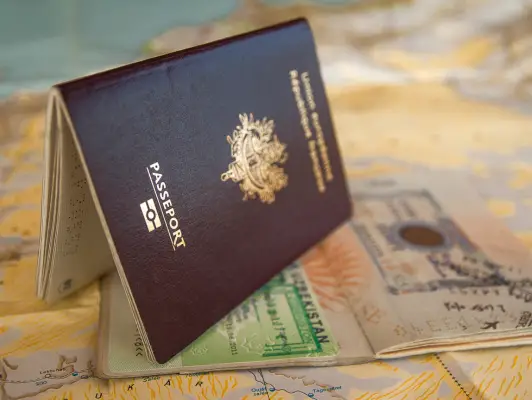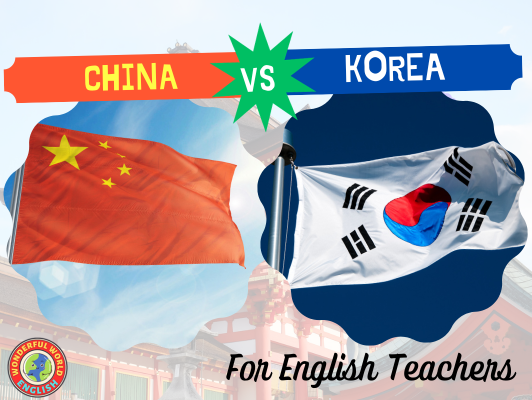Contents
Toggle
Meet David De’ Ath, founder, editor, and writer at Wonderful World English. With his extensive background as an English teacher, David provides valuable insights and practical tips on ESL for students and teachers alike.
Taking the step to teach English abroad is an exciting decision, and two destinations often rise to the top of the list: China and South Korea.
Both nations are rich in culture and history, offering English as a Second Language (ESL) teachers incredible experiences in and out of the classroom.
With its vast landscapes and ancient traditions, China contrasts South Korea’s blend of historical roots and modern vibrancy.
But which destination aligns more with your aspirations?
China offers a broad ESL market with diverse urban and rural placements and a mix of traditions. South Korea has positions set mainly in urban areas. Both promise cultural immersion, but China might pose more language barriers. Choose based on your comfort and growth desires.
In this article, we’ll dive into a straightforward comparison of teaching in both countries.
From the classroom environment to daily life, we’ll help you weigh the pros and cons, guiding you toward your ideal teaching adventure.
Let’s begin the journey!

Teaching English in China vs. Korea
Deciding where to embark on your ESL teaching journey in Asia can be both exciting and challenging.
China and South Korea stand out as two prominent destinations, each offering unique experiences and benefits.
From understanding work environments to navigating cultural nuances, this comparison aims to provide insights into what each country has in store for aspiring ESL teachers.
Whether you’re drawn to the vastness of China or the compact vibrancy of South Korea, let’s dive deep into what makes each destination unique:
1. Economic Overview
Choosing where to teach English abroad involves more than just cultural allure; the economic landscape, which affects potential earnings and living expenses, is also crucial.
In China, ESL teachers can expect monthly earnings between $1,800 and $3,000 per month.
This number is heavily influenced by city location, the institution, and one’s qualifications.
While smaller cities in China offer a gentler touch on the wallet, metropolitan hubs like Beijing or Shanghai present living costs that can match many Western cities.
South Korea presents a somewhat different economic picture.
English teachers in South Korea can expect to earn $1,800 to $3,000 per month.
This may be the same salary range as China, but living expenses tend to be higher in South Korea, especially in cities like Seoul, which can have consistently higher costs, although they remain predictable and steady.
Both countries have positions that offer added benefits such as flight reimbursement and free accommodation, although this depends on the school.
There is no standout winner, China does have a higher demand for ESL teachers and a generally lower cost of living, so we determine that China edges it from a financial perspective.
For more information on how you can become an English teacher in either China or South Korea, click on the flags below:


2. Cultural Experience
When considering a teaching position abroad, immersing oneself in the host country’s culture can be as transformative as the job itself.
China, a vast country known for its rich history and diversity, offers a unique cultural tapestry.
Boasting 56 ethnic groups, each with its traditions, festivals, and customs, the country is a kaleidoscope of experiences waiting to be explored.
While Mandarin Chinese is the overarching language, many regions have their distinct dialects.
As an ESL teacher in China, you might find yourself celebrating the vibrant Lantern Festival in one region and then savoring the local dishes of another, all while navigating the intricate linguistic variations.
On the opposite spectrum, South Korea provides a more concentrated cultural experience.
With its deep historical roots, the nation has a relatively uniform culture and language.
The South Korean way of life, from its traditional Hanbok attire to the celebrated Chuseok harvest festival, reflects a shared heritage that binds its people together.
While the Korean language dominates, you might encounter subtle regional accents, especially if you venture beyond the bustling streets of Seoul into the countryside.
China offers a cultural journey of discovery, where every region is different.
South Korea, on the other hand, invites you to dive deep into a more singular cultural narrative.
Depending on your personal preferences – whether you’re intrigued by the lure of diversity or drawn to the depth of a more unified cultural experience – both countries offer exciting paths for ESL teachers.

3. Work Environment
For ESL teachers considering a move abroad, the work environment significantly shapes the overall experience.
In China, the teaching schedule offers some flexibility.
On average, educators find themselves in front of a classroom for about 20-25 hours a week.
This can vary depending on the type of institution.
The country has various teaching opportunities, ranging from public schools and private language institutes to prestigious international schools and universities.
However, one thing to note is that some institutions’ vacation time in China can be a bit shorter, especially compared to its Korean counterpart.
South Korea presents a slightly different picture.
Teachers, on average, might be looking at a more packed schedule, with approximately 30 teaching hours a week.
The country primarily offers positions through its EPIK program, which places teachers in public schools.
However, plenty of Hagwons (private academies) and university positions are also available for those interested.
A notable perk for EPIK teachers is the generous 18 days of paid vacation, allowing ample time to explore the country or even venture out to neighboring nations.
In a nutshell, China offers a diverse teaching landscape with a potentially lighter workload, while South Korea provides a more structured environment with the benefit of extended vacation time.
As with any overseas venture, aligning your personal preferences with the work dynamics of each country can pave the way for a fulfilling teaching stint.
China and Korea aren’t the only Asian countries where English proficiency is highly regarded.
For a list of the most English-proficient nations in Asia, check out the guide below!
Related Article: What Asian Countries Speak English? – Full Guide

4. Benefits
When weighing options for teaching English abroad, understanding the benefits provided can significantly impact your decision.
Both China and South Korea offer attractive packages for ESL teachers, but there are subtle differences worth noting.
In China, teachers often find themselves in a comfortable position when it comes to housing.
Accommodations are usually either provided by the employer or subsidized, reducing the financial burden.
When it’s time to fly out, many institutions either reimburse the airfare or provide it upfront, ensuring that getting there isn’t a strain on the pocket.
Additionally, health is a priority, and teachers typically receive health insurance as a standard part of their benefits package.
Over in South Korea, the perks are equally tempting.
Accommodation is a standout benefit, with most ESL teachers receiving housing absolutely free of charge.
This can be a significant relief, especially for those new to the country.
When it comes to airfare, schools often go the extra mile by covering the costs of a round-trip ticket, ensuring teachers can travel without financial stress.
Health insurance in South Korea operates under a national system, and the costs are conveniently split between the employer and the teacher, offering comprehensive coverage at an affordable rate.
In summary, while both countries roll out the red carpet for ESL teachers with a host of benefits, the specifics vary.
China offers a mix of accommodations, airfare assistance, and health coverage, whereas South Korea shines with free housing, round-trip airfare, and a shared health insurance scheme.
Understanding these distinctions can help teachers make informed decisions that align with their needs and priorities.
If you want to know how much different countries around the world offer English teachers, click the link below!
Related Article: How Much Does Teaching English Abroad Pay?

5. Visa Process
Taking the plunge to teach abroad involves more than just passion and preparation; understanding the visa procedures of your chosen country is crucial.
Let’s dive into the specifics of China and South Korea.
In China, the visa prerequisites come with certain academic expectations.
Aspiring teachers need to be equipped with a bachelor’s degree and a TEFL certification.
Prior teaching or work experience might also be on the checklist in some regions or institutions.
Once you’ve met these requirements, brace yourself for a process stretching over time.
The visa application often involves comprehensive health checks and the submission of authenticated documents, which can elongate the timeline.
Contrastingly, South Korea offers a somewhat smoother sail on the visa front.
The non-negotiables include a bachelor’s degree and a spotless criminal background check.
A TEFL certification becomes mandatory if you’re eyeing the popular EPIK program.
The silver lining for many is that South Korea’s visa procedure, especially for those aligned with the EPIK program, tends to be more streamlined and user-friendly.
While China’s visa process can be thorough and potentially prolonged, South Korea’s approach leans towards efficiency and clarity.
As you plan your teaching journey, knowing these procedures can save you time and ensure a smoother transition to your new adventure.

6. Living Experience
Beyond the classroom, the broader living experience shapes how ESL teachers remember their time abroad.
The communities they become a part of and the travel opportunities at their fingertips can be influential.
Let’s compare the living experiences in China and South Korea.
In China, the feeling of camaraderie with fellow expats varies based on where you are.
Substantial expat communities thrive in sprawling metropolises like Beijing and Shanghai, offering a slice of familiarity amidst the exotic.
However, such communities may be more scattered in smaller cities or remote areas.
As for satiating the travel bug, China serves as a vast playground.
From the ancient Great Wall to the futuristic Shanghai skyline, the country’s diverse landscapes and historical treasures promise endless exploration.
South Korea offers a slightly different flavor.
Given the influx of foreign teachers, most cities’ expat communities are large and diverse.
This can be comforting, especially for those new to the country and seeking familiar connections.
South Korea’s compact size is a boon for travelers when the weekend rolls around.
Whether it’s the beaches of Busan or the palaces of Seoul, quick getaways are easily accessible.
Additionally, the country’s close proximity to neighbors like Japan, China, and Southeast Asia makes international weekend trips a tantalizing option.
While China offers vast exploration opportunities with varying degrees of expat interaction, South Korea promises a tight-knit expat experience combined with easy domestic and international travel.
As an ESL teacher, understanding these distinctions can help tailor a living experience that resonates most with your personal desires.

Conclusion
Deciding to teach English in either China or South Korea requires careful consideration.
China boasts deep cultural roots and traditions, perfect for those eager to immerse themselves in a rich historical tapestry.
South Korea, meanwhile, offers a blend of traditional and modern, coupled with a more structured teaching environment and some attractive benefits.
Your choice will greatly depend on your personal preferences, what you hope to achieve in your career, and your adaptability to different cultures.
Both countries provide unique opportunities for both personal and professional growth.
As you ponder your next steps, think about which country aligns more with your dreams and aspirations.
Thank you for diving into this comparison with us, and we wish you all the best in your teaching journey.
Image Attribution: All images licensed via canva.com





